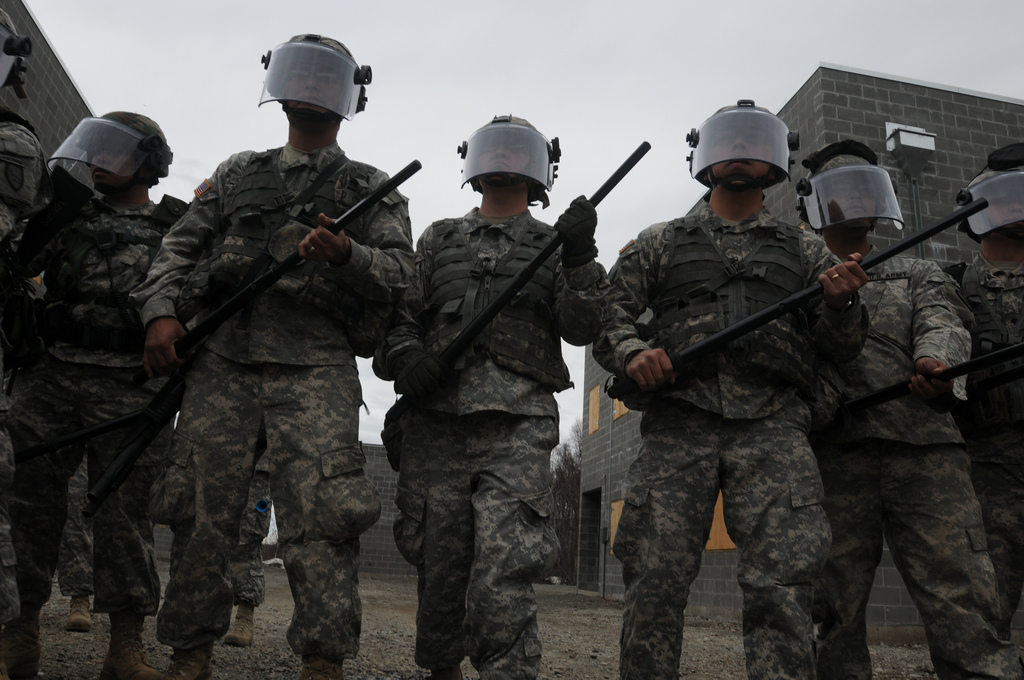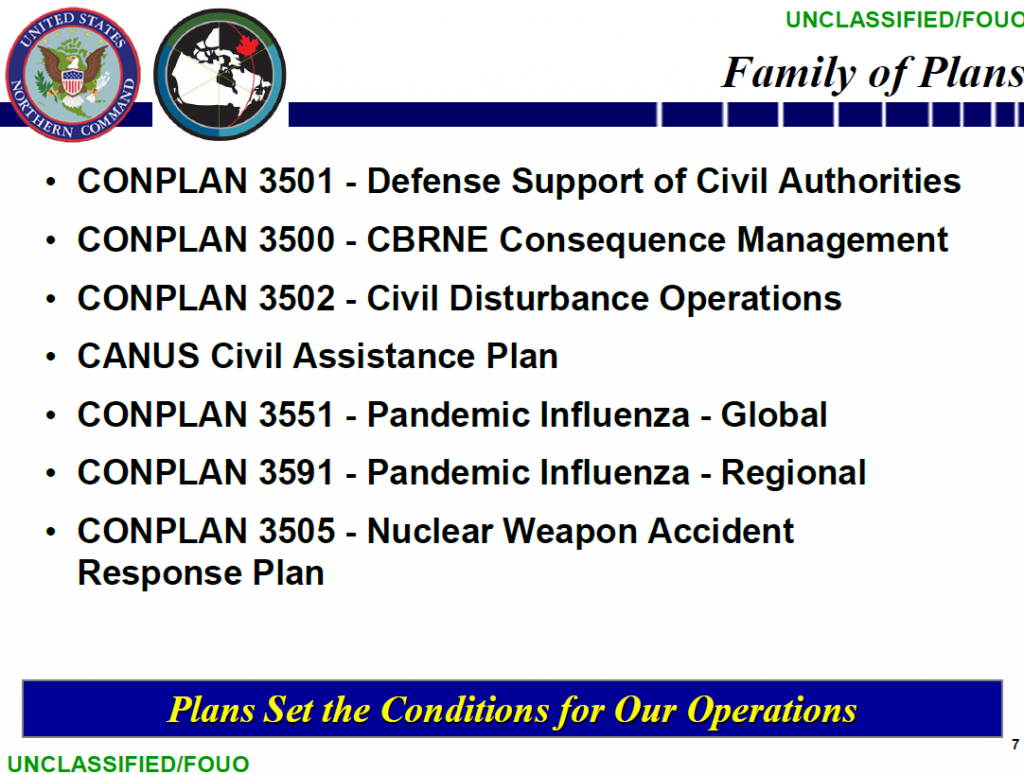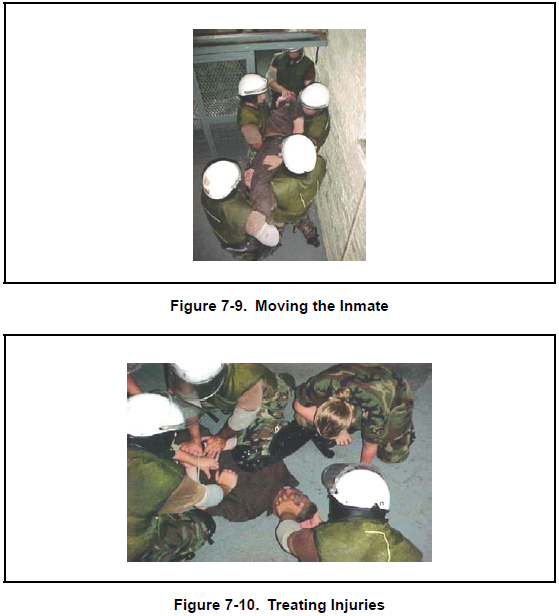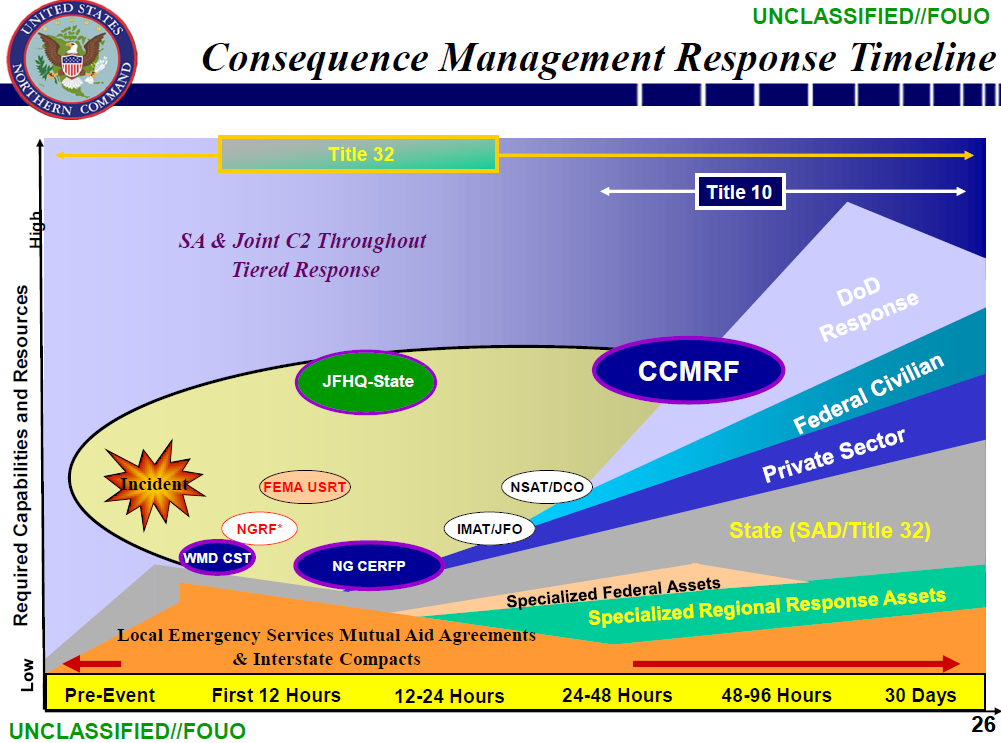The Military’s Plans for Social Unrest: CONPLAN 3502, Civil Disturbance Operations and Martial Law
August 15, 2011 in News

Alaska
Army National Guard Soldiers assist Anchorage Police to calm or detain
rioters as part of the training scenario of exercise Vigilant Guard Ft.
Richardson, Alaska, Wednesday April 28, 2010. Vigilant Guard is an
annual, disaster-based training scenario that tests the coordination of
National Guard units with local, state, regional, and national disaster
preparedness organizations. (U.S. Air Force photo by Tech. Sgt. Brian E.
Christiansen, North Carolina National Guard)
Recent unrest in London has sparked media interest in the U.S. military’s plans for civil unrest, including a report from the Atlantic on a little known document called CONPLAN 3502. With economies declining around the world and social unrest spreading throughout the Middle East and even into Western democracies, many wonder what would happen if this sort of unrest and violence were to spread to the United States. Would the response be measured and calm, respecting popular movements and upholding fundamental human rights, or would the response look something more like what is happening in Syria?
To understand just what would happen in the event of widespread unrest in the United States, you must first familiarize yourself with CONPLAN 3502, the classified military plan for civil disturbances. A slide from a U.S. Northern Command presentation previously published by this site indicates that CONPLAN 3502 is one of several Contingency Plans (CONPLANs) for domestic U.S. military operations in the event of a disaster, terrorist attack or national security special event (NSSE). Several of the plans deal with Defense Support to Civil Authorities (DSCA) in times of disaster or crisis, including pandemic influenza outbreaks, nuclear and radiological events, as well as chemical weapons attacks. Though, CONPLAN 3502 is unique in that it deals exclusively with support operations conducted with local authorities during times of “civil disturbance”. Because CONPLAN 3502 is classified “Secret”, it has not been released to the public and little is known of its contents. However, through bits of information found in a number of relevant documents, a fairly coherent picture of military civil disturbance planning may be ascertained.
Prior to the establishment of U.S. Northern Command (USNORTHCOM) in 2002, the U.S. Army controlled planning for military civil disturbance operations, producing at least four separate versions of an Operations Plan (OPLAN) commonly referred to as Garden Plot. Four separate versions of this plan were obtained via Freedom of Information Act requests made by GovernmentAttic.org, including plans going back as far as 1968. These plans served as the groundwork for domestic civil disturbance operations as late as September 11, 2001 when Garden Plot was activated as Operation Noble Eagle. Garden Plot described the tactics, techniques, and procedures used by military personnel to conduct law enforcement operations, including riot control, domestic reconnaissance and surveillance, military law enforcement and even forcible detention of U.S. citizens. The U.S. military claims these capabilities are legally afforded them under Title 10, Chapter 15 a section of U.S. Code that comes from the Insurrection Act of 1807.

A
slide from a U.S. Northern Command (USNORTHCOM) presentation detailing
the CONPLANs utilized for their operations, including CONPLAN 3502.
According to a variety of sources, Garden Plot has been activated a number of times since the 1960s. In fact, up until 1971 there were multiple standing brigades stationed in the U.S. for domestic civil disturbance operations. According to GlobalSecurity.org, Garden Plot was activated during the Los Angeles riots in 1992, during the Detroit riots in 1967, and following the assassination of Dr. Martin Luther King Jr. in 1968. After the creation of USNORTHCOM in 2002, Garden Plot was replaced with CONPLAN 2502 (now referred to as CONPLAN 3502). There are only a few known references to this CONPLAN in the military literature we can find. One of the most significant resources when trying to learn about the CONPLAN is the Domestic Operational Handbook for Judge Advocates, “a resource for operational lawyers involved in domestic support operations” that helps them understand “the legal issues inherent in such operations”. The Domestic Operational Handbook for 2010 includes many references to CONPLAN 3502, including notes that indicate that the plan contains information on the formation of detention facilities for imprisoning U.S. citizens during Civil Disturbance Operations (CDO). Because of the inherent limitations of the Posse Comitatus Act, only police can lawfully detain and hold civilians. However, page 77 of the 2010 Domestic Operational Law Handbook states:
If available civilian detention facilities cannot accommodate the number of detained persons who are awaiting arraignment, the Joint Civil Disturbance Task Force commander must seek the approval of the SCRAG and Combatant Commander to set up a temporary detention facility.
Should the Task Force be required to operate a detention facility, the detention facility standards and operations should conform, to the maximum extent possible, to current DoD confinement facility operations and will be under the professional supervision and control of Military Police personnel. The establishment and operation of military detention facilities is a temporary expedient and is authorized only until such time as the custody of detained persons can be transferred to civil authorities.
The 1991 version of Garden Plot, the precursor to CONPLAN 3502, includes instructions on the use of deadly force against U.S. citizens. Here is a basic listing of the requirements for deadly force found on page C-1-8:
Page C-8-9 of the same document describes criteria for conducting warrantless searches of people and property, seizure of property, as well as detention operations. Page E-4 specifically describes the role of CONPLANs: “Civil disturbance contingency plans governing the employment of federal forces will include provisions for providing detention assistance to civilian authorities. Plans for this assistance will cover the full range of possible support, from assisting police in guarding detainees to operating detention facilities. Such assistance will be predicated on the turnover of this responsibility to civil authorities as soon as practicable.”1 THE USE OF DEADLY FORCE IS AUTHORIZED ONLY WHERE ALL THREE OF THE FOLLOWING CIRCUMSTANCES ARE PRESENT:
A LESSER MEANS HAVE BEEN EXHAUSTED OR ARE UNAVAILABLE;
B THE RISK OF DEATH OR SERIOUS BODILY HARM TO INNOCENT PERSONS IS NOT SIGNIFICANTLY INCREASED BY USE;
AND
C THE PURPOSE OF ITS USE IS ONE OR MORE OF THE FOLLOWING:
1-SELF DEFENSE TO AVOID DEATH OR SERIOUS BODILY HARM; SELF DEFENSE AGAINST A HOSTILE PERSON OR FORCE TO AVOID IMMINENT DEATH OR SERIOUS BODILY INJURY POSED BY THE HOSTILE PERSON; (’96 Change)
2-PREVENTION OF A CRIME WHICH INVOLVES A SUBSTANTIAL RISK AN IMMIMENT DANGER (’96 Change) OF DEATH OR SERIOUS BODILY HARM (FOR EXAMPLE, SETTING FIRE TO AN INHABITED DWELLING OR SNIPING), INCLUDING THE DEFENSE OF OTHER PERSONS, WHERE DEADLY FORCE IS DIRECTED AGAINST THE PERSON THREATENING TO COMMIT THE CRIME; OR (’96 Change);
3-PREVENTION OF THE DESTRUCTION OF PUBLIC UTILITIES OR SIMILAR PROPERTY CRITICAL INFRASTRUCTURE (’96 Change) VITAL TO PUBLIC HEALTH OR SAFETY, DAMAGE TO WHICH WOULD IMPERIL LIFE (’96 Change); OR
4-DETENTION OR PREVENTION OF THE ESCAPE OF PERSONS WHO HAVE COMMITTED OR ATTEMPTED TO COMMIT ONE OF THE SERIOUS OFFENSES REFERRED TO IN SUBPARAGRAPHS 1, 2, AND 3 IMMEDIATELY ABOVE, BUT ONLY IF ESCAPE OF THE PERSONS WOULD POSE AN IMMINENT DANGER OF DEATH OR SERIOUS PHYSICAL INJURY TO MILITARY OR LAW ENFORCEMENT PERSONNEL OR TO ANY OTHER PERSON (’96 Change).
The 2010 Defense Support to Civil Authorities (DSCA) Handbook clarifies the current policy on the use of force, providing templates for soldiers engaged in civil support missions under Title 10 authority. The Handbook provides a relatively complex description of situations where the use of force is authorized, while also describing arming orders for vehicles and soldiers engaged in civil support missions.
U.S. Army Field Manual 3-19.15 gives complex instructions on searching and detaining individuals, conducting riot control operations, as well as creating “temporary detention facilities”. These detention facilities are to be located on “the nearest military installation or on suitable property under federal control” and “should be close enough to the disturbance area to minimize transportation and escort needs”. The manual emphasizes that these facilities should be built on “existing structures” that are “adapted for this use, but construction may be needed to provide segregation for ensuring effective control and administration.” In Chapter 7, there are even instructions for quelling riots and other disturbances inside these confinement facilities:
Civil disturbance doctrine is usually written for quelling disturbances that occur in large open areas where the size of the responding force or the type of formation employed is not hampered by a lack of space. However, in the military confinement environment, inmate disturbances often occur in small, closed areas, such as an inmate’s housing unit, a gymnasium, a dining facility, or a chapel where maneuver space and equipment limit the size of the element that may be employed. The layout of each facility is different and presents its own unique problems when employing forces. This chapter covers the use of small military police teams, forced cell move teams (FCMTs), and the formations used to move an unruly inmate from one cell to another.

Pictures
from U.S. Army Field Manual 3-19.15 describing how to move an "unruly
inmate" from his cell to another location within a military detention
facility.
Due to the lack of concrete information on CONPLAN 3502, it has not previously been understood what circumstances were required for implementation of the plan. It is clear that Civil Support operations are triggered by emergencies that rise beyond the capabilities of local authorities, though it was not clear what actually would initiate the implementation of the provisions in CONPLAN 3502. Some situations that are closer to legitimate acts of protest or civil disobedience could potentially be considered disturbances depending on the military’s intentions. For example, a civil disturbance training course for U.S. Army Military Police lists the Boston Tea Party of 1773 and the Pullman Strike of 1894 as examples of civil disturbances.
Last November, a researcher at Twin Cities Indymedia discovered a Powerpoint presentation on a publicly-accessible server operated by the U.S. Army Corps of Engineers that detailed the specific mechanism that initiates the implementation of CONPLAN 3502. The presentation stated that when civil disturbance operations (CDO) exceed Title 32 capability, CONPLAN 3502 is “triggered”. That is, when the civil disturbance exceeds the capabilities of the National Guard forces, a separate mechanism that is operated by the U.S. Army North (ARNORTH), the land component of U.S. Northern Command (NORTHCOM), is brought into operation. Understanding the distinction between the Title 32 and Title 10 capabilities afforded the military is a crucial part of domestic support and civil disturbance operations. The following slide from a NORTHCOM presentation demonstrates this distinction. When an emergency moves beyond the capabilities of state and local forces authorized under Title 32, the DoD and other components of the federal government are activated under Title 10.

A timeline from a USNORTHCOM presentation displays the movement from Title 32 to Title 10 capabilities.
All of this might sound pretty bad to people who value the U.S. Constitution and the rule of law, but things can still get worse than direct military intervention on U.S. soil. What happens when everything breaks down? What happens when the civil disturbance or other emergency rises beyond the capabilities of even the Title 10 authorities afforded the military? This is martial law, a principle defined in legal textbooks as simply the “will of the commanding general”. Martial law is literally a domestic military government. It is described in U.S. Army regulations as “temporary government by military forces over civilians in domestic territory”. Army Regulation 500-50 describes martial law in detail:
It is unlikely that situations requiring the employment of Federal Armed Forms during civil disturbance operations will necessitate the declaration of martial law. When Federal Armed Forces are employed in the event of civil disturbances, their proper role is to support, not supplant civil authority. Martial law depends for its justification upon public necessity. Necessity gives rise to its imposition; necessity justifies its exercise; and necessity limits its duration. The extent of the military force used and the legal propriety of the measures taken, consequently, will depend upon the actual threat to order and public safety, which exists at the time. In most instances, the decision to impose martial law is made by the President, who normally announces his decision, by a proclamation, which usually contains his instructions concerning the exercise of martial law and any limitations thereon . . . When Federal Armed Forces have been employed in an objective area in a martial law situation, the population of the affected area will be informed of the rules of conduct and other restrictive measures the military is authorized to enforce. These normally will be announced by proclamation or order and will be given the widest possible publicity by all available media. Federal Armed Forces ordinarily will exercise police powers previously inoperative in the affected area, restore and maintain order, insure the essential mechanics of distribution, transportation, and communications, and initiate necessary relief measures.
Recommended Resources:
- DoD Defense Support to Civil Authorities Handbook
- CJCS Defense Support of Civil Authorities (DSCA) Exord
- U.S. Army and U.S. Air Force “Garden Plot” Civil Disturbance Plans 1968-1991
- U.S. Army FM 3-19.15 Civil Disturbance Operations
- U.S. Military Police Internment/Resettlement Operations Manual
- U.S. Army Regulation 500-50 Civil Disturbances Emergency Employment of Army Resources
- U.S. Army Military Police Civil Disturbance and Martial Law Training Course
- U.S. Air Force Civil Disturbance Manual
- (U//FOUO) U.S. Northern Command (NORTHCOM) and CONPLAN 3500 CBRNE Response Overview
- Restricted U.S. Military Multi-Service Civil Support Operations Manual
- Vigilant Guard 2010 Riot Control, Detention Drills
Related Material From the Archive:
- U.S. Army Military Police Civil Disturbance and Martial Law Training Course
- U.S. Army FM 3-19.15 Civil Disturbance Operations
- NORAD and NORTHCOM Operations Plans Summary
- U.S. Military Civil Disturbance Standing Rules for the Use of Force (SRUF)
- Joint Task Force Civil Support (JTF-CS) Brief
- U.S. Air Force Civil Disturbance Manual
- U.S. Army Regulation 500-50 Civil Disturbances Emergency Employment of Army Resources
- Restricted U.S. Military Multi-Service Civil Support Operations Manual
The CON in CONPLAN means "Concept", not "Contingency". By "Concept" they mean that it is in, well, the planning stage. When it has been approved as a real contingency plan, it becomes an OPLAN that can be activated as an OPORD or operations order.
ReplyDelete